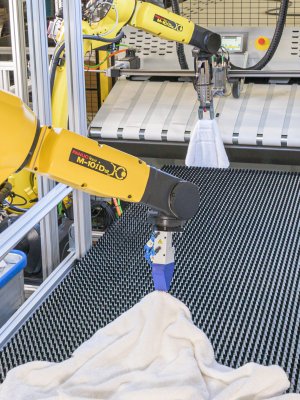Intelligent robotics for laundries closes automation gap

The textile and garment industry is facing major challenges with current supply chain and energy issues. The future recovery is also threatened by factors that hinder production, such as labour and equipment shortages, which put them under additional pressure. The competitiveness of the industry, especially in a global context, depends on how affected companies respond to these framework conditions. One solution is to move the production of clothing back to Europe in an economically viable way. Shorter transport routes and the associated significant savings in transport costs and greenhouse gases speak in favour of this. On the other hand, the related higher wage costs and the prevailing shortage of skilled workers in this country must be compensated. The latter requires further automation of textile processing. The German deep-tech start-up sewts GmbH from Munich has focused on the great potential that lies in this task. It develops solutions with the help of which robots – similar to humans – anticipate how a textile will behave and adapt their movement accordingly.
The German deep-tech start-up sewts GmbH from Munich has focused on the great potential that lies in this task. It develops solutions with the help of which robots – similar to humans – anticipate how a textile will behave and adapt their movement accordingly. In the first step, sewts has set its sights on an application for large industrial laundries. With a system that uses both 2D and 3D cameras from IDS Imaging Development Systems GmbH, the young entrepreneurs are automating one of the last remaining manual steps in large-scale industrial laundries, the unfolding process. Although 90% of the process steps in industrial washing are already automated, the remaining manual operations account for 30% of labour costs. The potential savings through automation are therefore enormous at this point.
Application
It is true that industrial laundries already operate in a highly automated environment to handle the large volumes of laundry. Among other things, the folding of laundry is done by machines. However, each of these machines usually requires an employee to manually spread out the laundry and feed it without creases. This monotonous and strenuous loading of the folding machines has a disproportionate effect on personnel costs. In addition, qualified workforce is difficult to find, which often has an impact on the capacity utilisation and thus the profitability of industrial laundries. The seasonal nature of the business also requires a high degree of flexibility. sewts makes IDS cameras the image processing components of a new type of intelligent system whose technology can now be used to automate individual steps, such as sorting dirty textiles or inserting laundry into folding machines.

„The particular challenge here is the malleability of the textiles,“ explains Tim Doerks, co-founder and CTO. While the automation of the processing of solid materials, such as metals, is comparatively unproblematic with the help of robotics and AI solutions, available software solutions and conventional image processing often still have their limits when it comes to easily deformable materials. Accordingly, commercially available robots and gripping systems have so far only been able to perform such simple operations as gripping a towel or piece of clothing inadequately. But the sewts system
Weiterlesen